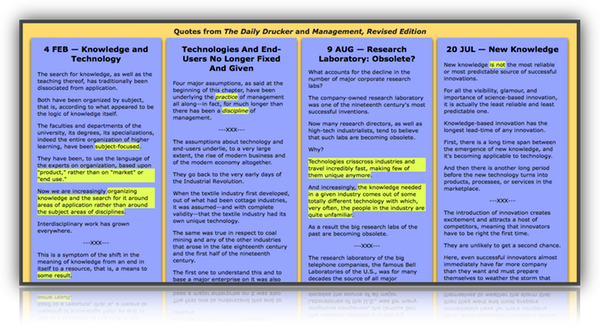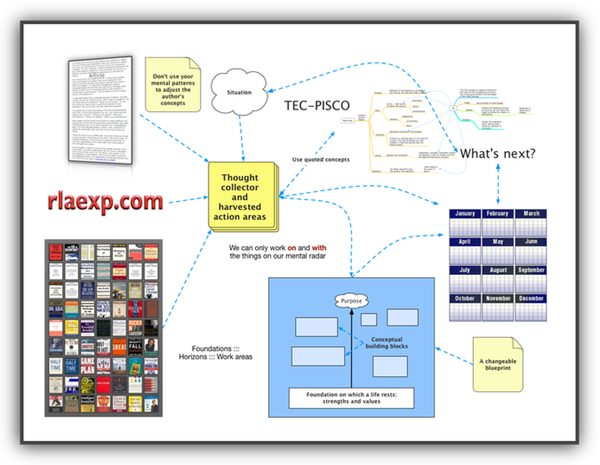The Wisdom of Peter Drucker
by Bob Buford
As a young CEO in a rapidly changing cable television industry, I knew I needed a perspective wider than my own.
The year was 1984, and I had already become an ardent fan of the writing of Peter Drucker, so I decided to take a chance and see if he would be willing to consult with me.
Thus began a wonderful relationship that continued until his death in 2005.
As you probably have already discovered from this book, his influence on my life finds its way into nearly everything I have written, and if you have ever heard me speak you know that I cannot get very far into my comments without referencing this remarkable man.
Peter Drucker is the “intellectual father” of nearly all that guides my philanthropy.
In 1997, Atlantic Monthly editor Jack Beatty interviewed me for two hours for a book he was writing, The World According to Peter Drucker.
That entire interview was distilled into only six words from me that truly describe our relationship:
“He’s the brains, I’m the legs.”
At the time of his death, at age ninety-five, Peter had taught for more than thirty years at California’s Claremont Graduate School, where the Management Center is named after him.
In addition to his career as a management professor—which includes twenty years at New York University—he published more than thirty books as well as articles for the Wall Street Journal, Harvard Business Review, Forbes, and many other periodicals—over four million words altogether!
Peter approached his teaching, writing, and consulting as a journalist doing an in-depth story.
He had an unparalleled grasp of the big picture and could tell you why the story was significant.
He had the realism of a newsman but the ideals of a philosopher and the heart of a quietly committed Christian.
It would be difficult to capture in this brief space all that I have learned from Peter, but here are the highlights, especially as they relate to the halftime journey:
Mission Comes First
Largely due to his influence, “mission statements” are in vogue in most businesses today.
But for Peter, a mission statement is more than ambitious intentions to be framed and hung on the board room wall.
It is what drives everything the company does — for example
Whether he was talking to CEOs, pastors, managers, or individuals contemplating a halftime experience, his counsel was always the same,
“Don’t ask ‘what should I do,’ but ‘what needs doing?’”
According to Peter, good intentions (“I want to do something significant”) is only a starting point.
The goal is results and performance that fulfills a clearly stated mission—something that needs doing—something that creates value for a customer. check this out
Peter told me over and over, “All results are on the outside.
On the inside is only cost and effort.”
(calendarize this?)
Also see
 Mission Mission
 The Five Most Important Questions You Will Ever Ask About Your Organization The Five Most Important Questions You Will Ever Ask About Your Organization
 How to guarantee non-performance How to guarantee non-performance
 Management by Objectives — a user’s guide Management by Objectives — a user’s guide
Find “objectives” on this page
Build on Islands of Health and Strength
When I began thinking about how I could focus my energy, talents, and resources on a more significant second half, I intuitively knew I wanted to work with churches.
It was Peter who helped me see that I could accomplish more for God’s Kingdom by working with larger, successful churches because these healthy institutions influence thousands of other churches.
My mission was to release the latent energy in the church, and he showed me I could accomplish more and in less time by focusing on larger churches who had huge resources of latent energy just waiting to be released.
“Work only on things that will make a great deal of difference if you succeed,” he once told me.
Similarly, Peter believed that individuals need to engage in second half careers built on the strengths and talents they already have.
“The World is Full of Options”
You do not have to reinvent (read this) yourself for a successful halftime; instead, you need to find ways to deploy your “best self” in new and significant ways.
(calendarize this?)
Focus on Opportunities, Not Problems
According to Peter, most organizations assign their best resources to problems when, instead, they should direct their best people, thinking, and resources to find and exploit opportunities.
Peter once told me, “Life is not that long.
You can spend your whole life working with people who are receptive to what you want to do.”
He taught me not to spend priceless time being “against” or trying to convince people to do what they really didn’t want to do.
It was my work to find and connect energetic leaders who were receptive to the body of ideas called “Management” in order to build and multiply their growing, high energy churches.
For the individual, Peter felt the most effective way to self renewal was to look for unexpected success and build on it.
Peter taught me not to curse the darkness, but to run towards the light.
(calendarize this?)
See opportunities
Organization efforts: Problems or Opportunities
The “Parallel Career”
Peter was fascinated with the huge transition facing the Baby Boomers as they approached midlife.
He accurately predicted that retirement would become increasingly unattractive to vibrant, healthy people who, as they approached their sixties, had reason to expect at least another twenty years of capacity and did not want to spend it in a rocking chair.
It was Peter who helped me understand the concept of the “parallel career”—continuing with your present career as you explore new opportunities for the second half.
Most people are unable to quit their “day job” and head into halftime, so the parallel career offers a realistic transition and eventually replaces the primary career.
No surprises
(calendarize this?)
The Shift from Industrial Work to Knowledge Work
Peter saw this coming well before we entered the “information age” and called it the most extreme societal change in recorded history.
Previous generations really could not expect a vibrant and productive “second half” because their daily work simply wore them out.
After twenty-five to thirty years working in a factory, tilling the fields, building highways, and so on, retirement was not only well earned but necessary.
And brief, due to shorter life expectancy. (a change in the human condition)
Today, most workers sit at desks, attend meetings, negotiate the Internet, and conduct business on cell phones—all using the same tool to grow their businesses: knowledge.
By the time you hit your forties, you may be burnt out or sensing the need for a change, but physically you have yet to hit your peak and have at least another twenty-five years of high energy capacity before you.
This one change is what led Peter to be so optimistic about the idea of halftime and predicted what has already begun happening: more and more successful people entering a second half of significance.
Managing Oneself — a revolution in human affairs
(calendarize this?)
Planned Abandonment
Peter felt it was just as important—maybe more important—to decide what not to do as it was to decide what to do.
Rick Warren, who also benefited from Peter’s counsel, calls this “the power of no.”
The human tendency, largely driven by ego, is to believe we can do it all.
When people approach me with a request to help them with a particularly exciting project, I have to recall Peter’s advice to “get rid of investments in management ego” for projects that yield little results for the customer.
It may be humbling to admit there are only a few things you do really well, but once you accept that fact, you will free yourself to focus on those things which will lead to greater personal success and significance.
See planned abandonment
(calendarize this?)
The Role of the Social Sector
Most people think of Peter Drucker as the “father of modern management,” which he was (though he was never very comfortable with that description).
And while it’s true that most of the very successful corporations owe a lot of their success to him, Peter increasingly turned his attention to the social sector—nonprofit organizations whose role is to look after the social needs of a culture.
Peter felt strongly that while government has a critical role to play as policy maker, standard setter, and paymaster, it should not attempt to run social services because it has proven to be almost totally incompetent in that area.
He also believed it was not a primary role of business to provide for the social needs of citizens.
Instead, nonprofit agencies—of which more than fifty percent are churches and faith-based organizations—have the greatest potential for doing the greatest good.
But as Peter would often say, “Don’t mistake potential for performance,” and devoted a great deal of his time helping the social sector, including churches, becoming more effective by becoming better managers.
I know that some have criticized larger churches for becoming more “businesslike” by adopting modern management principles, but Peter was adamant that the function of management is to make the church more churchlike, not make it more businesslike.
(calendarize this?)
He saw such huge potential within churches to care for the social needs of the nation (see chapter titled “Citizenship Through the Social Sector” in Post-Capitalist Society) , especially within the ranks of Baby Boomers who will be looking for more meaningful options to retirement.
The Importance of the Customer
Peter was fond of three basic questions he would ask over and over:
What is your business? (concerns contribution not product or service name and applies to all institutions of society)
Who is your customer? (not the same thing as who is your target customer)
What does your customer value? (what’s humanly important to them—really what’s their behavior and not just their words)
To Peter, these three questions needed to be asked by the church as well.
He believed an organization begins to die the day it begins to run for the benefit of the insiders and not for the benefit of the customers.
Over the years, Leadership Network (www.leadnet.org), the organization I founded when I entered my second half, has gone through several strategic changes (see organization evolution), many that were initiated by returning to those three questions.
(calendarize this?)
The Five Most Important Questions You Will Ever Ask About Your Organization
The Definitive Drucker
Marketing
Becoming an Adult
Peter once said to me, “The beginning of adult life is when you ask the question, ‘What do I want to be remembered for?’”
Essentially, this is the question of halftime.
It speaks of legacy more than accomplishments and gets at the heart of significance.
Nothing focuses your attention on legacy more than trying to write your own epitaph, which I shared with you in the Introduction (Opening the Heart’s Holiest Chamber) to this book.
It forces you, while in good health and decades ahead of you, to think about what matters most to you (after some serious exploration and thinking.
(calendarize this?)

The Second Half of Your Life

Career / life vision guidance from Peter Drucker — extremely, extremely, extremely valuable attention-directing concepts and ideas from a long-term standpoint.




Half Time series

Amazon
Amazon links (work-around for browser ad blocking)

“Time Related” Management Books
Important ways to “see” otherwise invisible aspects of reality and to relocate one's brain to unfamiliar territory.
Some of the chapter topics have made their way into The Daily Drucker
The subtopics below selected book titles are not the entire contents that book.
 Managing in Turbulent Times Managing in Turbulent Times
 Toward the Next Economics and Other Essays Toward the Next Economics and Other Essays
 The Changing World of The Executive The Changing World of The Executive
 A Scorecard for Management A Scorecard for Management
… “bottom line” is not even an appropriate measure of management performance
 Performance in Appropriating Capital Performance in Appropriating Capital
 Performance on People Decisions Performance on People Decisions
 Innovation Performance Innovation Performance
 Planning Performance (reality vs. expectations) Planning Performance (reality vs. expectations)
 Learning From Foreign Management Learning From Foreign Management
 Demand responsibility from their employees Demand responsibility from their employees
 Thought through their benefits policies more carefully Thought through their benefits policies more carefully
 Take marketing seriously — knowing what is value for the customer Take marketing seriously — knowing what is value for the customer
 Base their marketing and innovation strategies on the systematic and purposeful abandonment Base their marketing and innovation strategies on the systematic and purposeful abandonment
 Longer-term investment or opportunities budgets Longer-term investment or opportunities budgets
 Leaders responsible for the development of proper policies in the national interest Leaders responsible for the development of proper policies in the national interest
 Aftermath of a Go-Go Decade Aftermath of a Go-Go Decade
 Managing Capital Productivity Managing Capital Productivity
 Measuring Business Performance Measuring Business Performance
Performance in a business means applying capital productively and there is only one appropriate yardstick of business performance: return on all assets employed or on all capital invested
 Good Growth and Bad Growth Good Growth and Bad Growth
 Managing the Knowledge Worker Managing the Knowledge Worker
 Frontiers of Management Frontiers of Management
 Measuring White Collar Productivity Measuring White Collar Productivity
 Getting Control of Staff Work Getting Control of Staff Work
 Slimming Management’s Midriff Slimming Management’s Midriff
 The No-Growth Enterprise The No-Growth Enterprise
 Why Automation Pays Off Why Automation Pays Off
 Managing for the Future Managing for the Future
 The New Productivity Challenge The New Productivity Challenge
 Manage by walking around — Outside! Manage by walking around — Outside!
 Permanent cost cutting: permanent policy Permanent cost cutting: permanent policy
 Four marketing lessons for the future Four marketing lessons for the future
 Company performance: five telltale tests Company performance: five telltale tests
 Market standing Market standing
 Innovative performance Innovative performance
 Productivity Productivity
 Liquidity and Cash Flows Liquidity and Cash Flows
 Profitability Profitability
 No Precise Readings No Precise Readings
 The trend toward alliances for progress The trend toward alliances for progress
 The emerging theory of manufacturing The emerging theory of manufacturing
 Sell the Mailroom. Unbundling in the ‘90s Sell the Mailroom. Unbundling in the ‘90s
 Managing in a Time of Great Change Managing in a Time of Great Change
 The theory of the business The theory of the business
 Planning for uncertainty Planning for uncertainty
 The five deadly business sins The five deadly business sins
 Management Challenges for the 21st Century Management Challenges for the 21st Century
 Managing in the Next Society Managing in the Next Society
Keywords: tlnkwwisdom
|


![]()